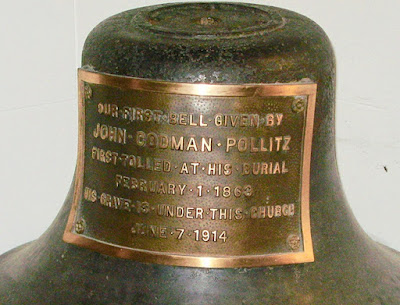 |
| Current location of the Polllitz headstone (Trinity Episcopal Church) |
The Picket
wrote two articles about the unusual circumstances involving parishioner Pvt.
John Codman Pollitz, who died in 1863 while serving with the 44th Massachusetts
in North Carolina.
Trinity Episcopal Church in Roslyn has long known that Pollitz’s 1863 grave was incorporated within the current
building during construction in 1906. But most of them had no idea where; there
was no recorded location.
“My assumption was that the headstone was too high standing
up for the crawlspace. I believe they simply laid it down on that same spot”
during the 1906 construction, church property manager and sexton Mike Callahan
told the Picket.
 |
| Removal of the floor exposed headstone for John C. Pollitz (Trinity Episcopal) |
At the time, the church said it was trying to determine what
to do with the headstone.
“Plans are to
build a cabinet mounted on the wall, but that’s going to take some engineering,”
Father George Sherrill, priest in charge, told the Picket in a recent email. “The stone weighs a ton and affixing to the wall is
going to be difficult, so no real timetable as of yet.”
The priest said the headstone does elicit conversation when people see
if for the first time.
The headstone is currently propped up against a bell that has its own interesting
history.
 |
| Bell was used during the funeral (Courtesy of Trinity Episcopal) |
It’s believed that the young Pollitz was living in Boston and barely 18 when he joined up with the 44th Massachusetts, ostensibly in the summer of fall of 1862.
The regiment, which took part in
skirmishes and sieges across North Carolina before it was mustered out in June
1863, was in New Bern for several months before transfer to Plymouth, N.C.
A history of the regiment detailed disease and illness that stalked the troops during campaigning and at their quarters. Pollitz, who served in Company F, died on Jan. 7, 1863 in New Bern.
 |
| Sons of Union Veterans lead 2019 ceremony near plaque (Trinity Episcopal) |
His remains were sent north to Long Island.
“Shortly after his burial, February 1, 1863, the bell was taken down and
another put in its place. John Pollitz’s bell was inverted, filled with dirt
and flowers, and stood by his grave for many years,” a church newsletter states.
In 1914, the bell was moved and restored after church
officials discovered the grave under that floor while investigating a break in
the foundation walls, according to The Times.
 |
| Construction of floor during 2018 (Trinity Episcopal Church) |
No comments:
Post a Comment